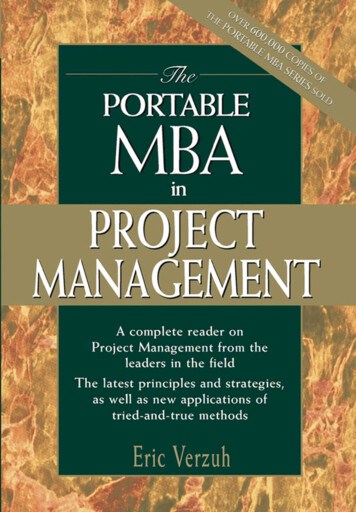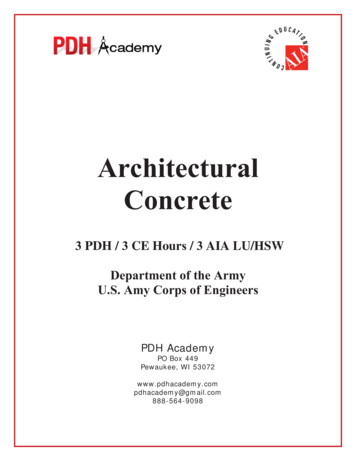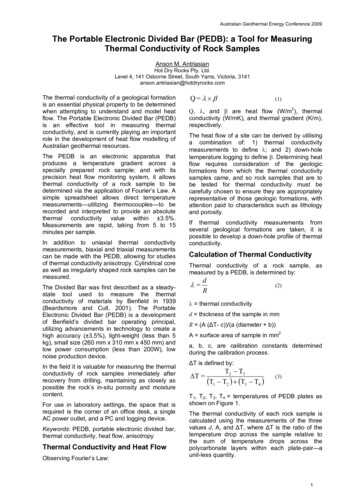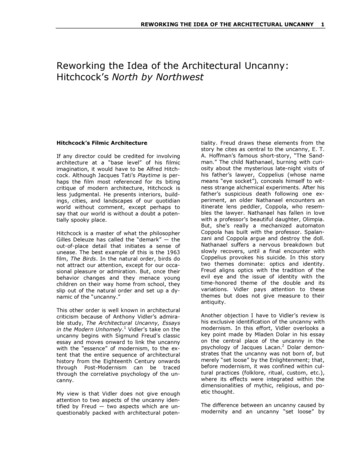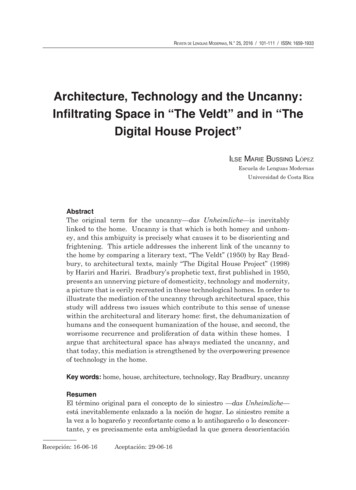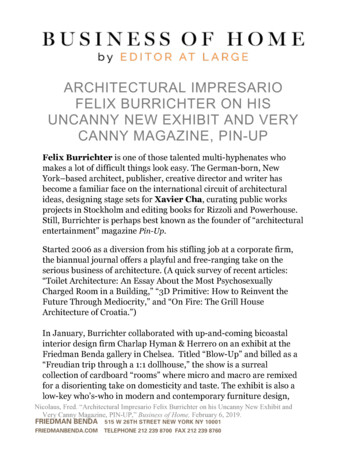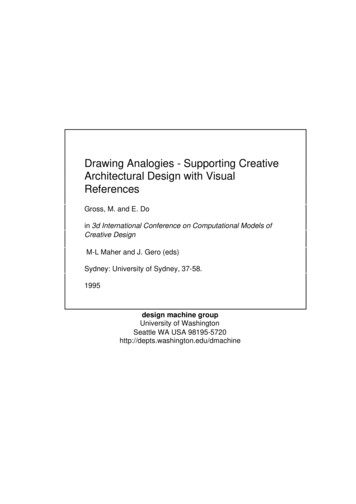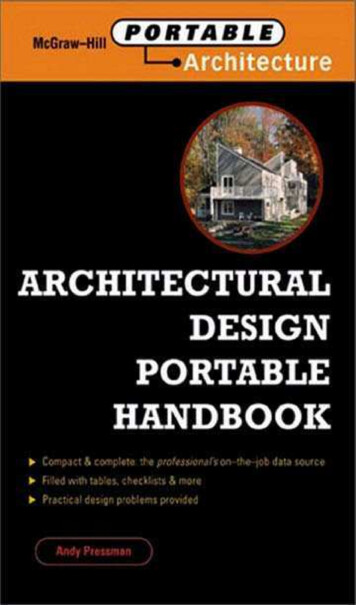
Transcription
ArchitecturalDesign PortableHandbook
This page intentionally left blank.
ArchitecturalDesign PortableHandbookA Guide to Excellent PracticesAndy Pressman, NCARB, AIAMcGRAW-HILLNew York Chicago San Francisco LisbonLondon Madrid Mexico City Milan New DelhiSan Juan Seoul Singapore Sydney Toronto
Copyright 2001 by Andy Pressman. All rights reserved. Manufactured in the United States of America.Except as permitted under the United States Copyright Act of 1976, no part of this publication may bereproduced or distributed in any form or by any means, or stored in a database or retrieval system, without the prior written permission of the publisher.0-07-141804-0The material in this eBook also appears in the print version of this title: 0-07-135214-7.All trademarks are trademarks of their respective owners. Rather than put a trademark symbol afterevery occurrence of a trademarked name, we use names in an editorial fashion only, and to the benefitof the trademark owner, with no intention of infringement of the trademark. Where such designationsappear in this book, they have been printed with initial caps.McGraw-Hill eBooks are available at special quantity discounts to use as premiums and sales promotions, or for use in corporate training programs. For more information, please contact George Hoare,Special Sales, at george hoare@mcgraw-hill.com or (212) 904-4069.TERMS OF USEThis is a copyrighted work and The McGraw-Hill Companies, Inc. (“McGraw-Hill”) and its licensorsreserve all rights in and to the work. Use of this work is subject to these terms. Except as permittedunder the Copyright Act of 1976 and the right to store and retrieve one copy of the work, you may notdecompile, disassemble, reverse engineer, reproduce, modify, create derivative works based upon,transmit, distribute, disseminate, sell, publish or sublicense the work or any part of it without McGrawHill’s prior consent. You may use the work for your own noncommercial and personal use; any otheruse of the work is strictly prohibited. Your right to use the work may be terminated if you fail to comply with these terms.THE WORK IS PROVIDED “AS IS”. McGRAW-HILL AND ITS LICENSORS MAKE NO GUARANTEES OR WARRANTIES AS TO THE ACCURACY, ADEQUACY OR COMPLETENESS OFOR RESULTS TO BE OBTAINED FROM USING THE WORK, INCLUDING ANY INFORMATION THAT CAN BE ACCESSED THROUGH THE WORK VIA HYPERLINK OR OTHERWISE,AND EXPRESSLY DISCLAIM ANY WARRANTY, EXPRESS OR IMPLIED, INCLUDING BUTNOT LIMITED TO IMPLIED WARRANTIES OF MERCHANTABILITY OR FITNESS FOR APARTICULAR PURPOSE. McGraw-Hill and its licensors do not warrant or guarantee that the functions contained in the work will meet your requirements or that its operation will be uninterrupted orerror free. Neither McGraw-Hill nor its licensors shall be liable to you or anyone else for any inaccuracy, error or omission, regardless of cause, in the work or for any damages resulting therefrom.McGraw-Hill has no responsibility for the content of any information accessed through the work.Under no circumstances shall McGraw-Hill and/or its licensors be liable for any indirect, incidental,special, punitive, consequential or similar damages that result from the use of or inability to use thework, even if any of them has been advised of the possibility of such damages. This limitation of liability shall apply to any claim or cause whatsoever whether such claim or cause arises in contract, tortor otherwise.DOI: 10.1036/0071418040
To Jacob Pressman, who is a constant reminder toview the world with fresh and positive perspective,humor, intelligence, and above all, playfulness, joy,and wonder.
This page intentionally left blank.
contentsFor more information about this title, click here.Foreword / xiPreface / xiiiAcknowledgments / xvii1 Inspiration1The Goose Bump Factor: A Conversation with AntoinePredock / 5What Is Good Design? / 6Peer Review and Self-Criticism / 33Critical Thinking in Architectural Design: With ChristopherMead / 36Why Draw? With Jean Pike / 45Vernacular Means: With Christopher Wilson / 48Setting Precedents for Using Precedents: With Roger K.Lewis / 56Daily Bread: With Melissa Harris / 61Designing Your Time: With Nancy Greiff / 742 The Program81Ten Ways of Looking at a Building: With Ralph Caplan / 86Orchestrating Client Involvement: With Edie Cherry / 90Communication with Your Client: A Decision PyramidApproach to Design Excellence: With Min Kantrowitz / 99Information Gathering / 103Conceptual Design Cost Estimating: With Brian Bowen / 115The Value of Value Engineering: With Glenn Fellows / 131Building Codes and Standards: With Marvin Cantor / 134The Carrot in the Codes: With Barry Yatt / 137Universal Design: With Michael Crosbie / 142Analysis and Interpretation of Information / 147A Client’s View of the Design Process: A Conversation withScott Gordon / 158viiCopyright 2001 by Andy Pressman. Click Here for Terms of Use.
The Place of People in Architectural Design: With GeraldWeisman / 1583 The Site171Appreciating the Environment / 176Landscape Architecture: With Lawrence Halprin and PaulFriedberg / 176Well-Grounded Design, or It’s Not Easy BeingGreen / 181Environmentally Sensitive Design: A Primer: WithStephen Dent / 182Architecture and Sustainability Case Study: With RandolphCroxton / 199Basic Examples of Site Influences on Design / 201Site Inventory Checklist / 206Diagramming Site Data / 212Marrying Program and Site / 214Shedding (Day)light on Design: With VirginiaCartwright / 219The Art of Parking: With Mark Childs / 229Design Value and the Modern Machine: With BakerMorrow / 2384 Architectural Design243Facilitating Design / 245Brainstorming Tips / 246Tools / 262Drawings / 263Drawing as Discovery: With Paul Laseau / 265Physical Models / 276Computers: With Glenn Goldman / 281Construction Technology / 302Thinking and Making: With Geoffrey Adams / 303Tectonics: Art/Techne: With John Brittingham / 310Working with Constructors: With Raymond Worley / 316Materials / 318viii
The Nature of Materials: With Terry Patterson / 320Using Common Materials in Uncommon Ways: WithChristopher Jofeh / 323Color: With Deborah Sussman / 331Building Systems Integration / 333The Technical Integration Game: With Carl Bovill / 334Structures: With Denis McMullan and Mete Turan / 339Mechanical Systems: With Norbert Lechner / 361Lighting / 366Lighting Design: With Charles Linn / 369Acoustics: With Gary Siebein / 371Orchestrating Design / 392The Symphony / 393Community Design: With Richard Nordhaus / 4005 Presentations413Another Design Problem / 416Presenting for Pros: With Karen Greenstreet and BobGreenstreet / 422Quick and Dirty Refresher Tips / 430Architectural Presentations as Graphic Art: A Conversationwith Iris Slikerman / 436Engaging Your Client: With Kathryn Anthony / 440Trends in Reprographics, Printing, and Imaging: AConversation with Jim Maitland / 447Architectural Photography: With Steve Rosenthal, CharlesLinn, and Norman McGrath / 453Design Intelligence and the Art of Persuasion: With JamesCramer / 4596 Lifelong Learning463The Pursuit of Professional Development ThroughContinuing Education: With Thom Lowther / 466Competitions: Learning Opportunities or Exploitation? / 471Details of Design Competitions: A Conversation with RogerSchluntz / 475ix
Travel: With John Cary Jr. and Casius Pealer III / 486Architectural Internship / 490Optimizing Internship Experience for Interns and Employers:With Rob Rosenfeld / 491Seeking a Job / 497In the Trenches / 504A First Job: With Michael Sobczak / 507Open Letters to Advanced Students: By Helmut Jahn, HughJacobson, Arthur Erickson, and Charles Moore / 508The Architect Registration Examination: With StephenSchreiber / 5147 The Future: A Manifesto527Getting at Design: A Conversation with Thom Mayne / 531Awards Programs: “You Like Me! You Really Like Me!” / 541Marginalization: Not Just a Formatting Problem / 549Getting Wired: A Conversation with Michael Pyatok / 553Preservation: A Cultural Legacy Under ArchitecturalStewardship: With Marilys Nepomechie / 562Meditations on Quality: Considerations for Designing: WithGregory Palermo / 570Toward Great Architecture: Top 10 Snippets / 587General References / 591Index / 593About the Author / 606x
foreword This is a guide to the uniquely provocative andoften idiosyncratic process of creating meaningfularchitectural form. So deep is the mystique of thearchitectural design process that few have had thecourage or insight to write about it. A feeling persists among many in the profession that design is analmost magical pursuit that defies analysis or rational discussion. But every architect, from thosewhose work adorns the magazines each month tothose who only read the magazines, can becomebetter at design, and this is what Andy Pressman,through this book, sets out to help us do.Pressman identifies and explains the core issuesof design, all the while keeping an eye on the elements of delight and mystery that make the designprocess so fascinating to those of us who engage init. He maintains a sharp focus on the magicalaspects of design, revealing their secrets to us sothat we may become better designers. He tells ushow to keep our minds free and open as we work.He helps us to realize our full potential as designers.This is a book to be read slowly, a few pages at atime, so as to absorb its lessons as completely aspossible. It is a book to be read again and again, abook whose pages will gradually become dog-earedand graphite-smudged, a comforting companion forthe times when a design concept refuses to emergeas well as the times when we experience theeuphoria of developing a brilliant scheme. For theseasoned practitioner, it will refresh the imagination, provide outstanding new tools for design, andresharpen existing tools. For the novice, it will furnish the elements of a personal design method,extend the range of the imagination, and help todevelop mental flexibility. For readers of all levelsof experience, it will put temporary troubles in per-xiCopyright 2001 by Andy Pressman. Click Here for Terms of Use.
spective and assist in recalling the worthy dream withwhich we all began, that of designing wonderful, endlessly fascinating buildings.Wisely, Andy Pressman has not attempted this taskalone. Dozens of architects and educators, through essaysand interviews, have contributed valuable insights intotheir particular specialties and their design experience ingeneral. Despite the diversity of their backgrounds andopinions, there is an impressive unanimity regarding theunderlying principles of successful process and outcome.In this respect especially, this is an authoritative volume.You can believe what it tells you. Keep it by your side.Read it well and understand it. It will enrich your practice and contribute to your continuing professional development.The act of architectural design is miraculous. Reviewing in my mind my own experiences as a young internworking with superb designers, as an independent architect, and as a studio teacher, I marvel at its audacity andpower. The ability to design things well is a gift of inestimable value. The words on these pages celebrate thisgift and enhance its worth.Edward AllenSouth Natick, MassachusettsJanuary 2001xii
preface Architectural Design Portable Handbook is primar-ily intended to assist professionals in creating excellent designs, particularly in the early phases ofprojects. This highly focused tool offers explicitguidance on how to view, attack, or accomplish specific tasks to facilitate optimal design solutions.The book also promotes critical reflection aboutthe meaning of architecture beyond function andbudget—although those issues are carefully analyzedas well; theoretical and practical concerns are intertwined. This is achieved without excessive ideological narrowness or zeal, so that practitioners (andadvanced students) with diverse backgrounds anddegrees of experience will embrace the book andbenefit more fully from its use.As with any of the great professions, valuablecontinuing education in architectural design mustrest upon a foundation of specialized knowledge,acquisition of focused skills, systematic development of talent, and practice. Architectural DesignPortable Handbook should augment this foundationand at least serve to bridge the various componentsinvolved in making sense of ongoing progress inarchitecture.Approaches to various aspects of the designprocess are illuminated in supplements contributedby nationally recognized academicians and practitioners in their respective areas of expertise. Thecollective effort provides capsules of wisdom andenlivens the text with energy, pragmatism, and idealism. The result is a rich and varied mixture ofinspirational, provocative, and at times even contradictory statements—all geared toward infusing acreative spirit within the controversial realm ofmeaningful design. I have specifically solicited,linked, and interpreted the material with a singlexiiiCopyright 2001 by Andy Pressman. Click Here for Terms of Use.
voice and perspective in what I consider a rational conception of practicing architecture.Topic coverage is tailored to the needs of workingarchitects. Practitioners will find the bulleted summarylists and blank sketch pages—a sort of personal sketchbook on steroids—especially helpful when thinking aboutprojects on an airplane, in the office, or while waiting fora client.Key elements include: Critical thinking in architectural designInfluence of the vernacularOrchestrating client involvementArchitecture and sustainabilityExamples of site influences on designAesthetic issues, organizing elements, and brainstorming tipsDaylightingBuilding codes and universal designComputing, drawing, and physical modelingStructures, mechanical systems, lighting, andacousticsMaterials, tectonics, construction, and systems integrationConceptual design cost estimatingPresentations and engaging the clientTime managementProfessional development, internship, and theArchitect Registration Examination (ARE)Demarginalizing practice, ethics, and awardsFinally, I hope Architectural Design Portable Handbooksuggests something about the impact of our profession.Our collective professional morale and our very passionfor the work of architecture have likely suffered in recenttimes. With ever increasing economic pressures, togetherwith the seemingly ever present confusion about whatarchitecture is or should be, it is clear to me that recogni-xiv
tion and discussion of genuine architectural achievementcan only be positive. At its grandest, architecture (andarchitects) can have enduring effects on society. At itsmost mundane, architecture can have an influence on thequality of a day—and, to paraphrase Thoreau, that maybe the highest of arts. I trust that this book has marshaledsufficient evidence to support these assertions and remindus of the really noble possibilities intrinsic to the profession.In sum, Architectural Design Portable Handbookattempts to unravel some of the mystery of creating themost beautiful, responsive, and responsible architecturaldesign possible.Andy PressmanAlbuquerque, New MexicoJanuary 2001xv
This page intentionally left blank.
acknowledgments Wendy Lochner, Edward Allen, and Norman Rosenfeld, for recognizing the value of theundertaking.Amanda Miller, for unconditional support.Iris Slikerman, Aldo Coppelli, and BobDeschamps, for graphic wisdom and insight.Marlene Stutzman, for keen editorial advice andguidance.Peter Pressman and Eleanor Pressman, as always.The many contributors to this book, who, over along period of time or just recently, have helpedshape my constantly evolving views about architectural design. I’m especially grateful to thisgifted, unique, and generous group of individuals, whose expertise dramatically enriches thecontent herein.xviiCopyright 2001 by Andy Pressman. Click Here for Terms of Use.
This page intentionally left blank.
chapter 1Inspiration“A journey of athousand miles mustbegin witha single step.”—Lao-tzuArchitectural Design Portable HandbookCopyright 2001 by Andy Pressman. Click Here for Terms of Use.1
Inspiration This initial chapter must begin with a general caveat regard-ing the presentation of material throughout the book. At firstglance, the contents may seem to advocate a linear approach tothe design process. My interview with Antoine Predock indicates explicitly why nothing could be further from the truth. Thelinearity inherent in the format of this text may be viewed as anecessary evil; it makes it possible to discuss an ambitious volume of material with some semblance of rationality, organization, and clarity. However, the very essence of this book lies in adeparture from algorithms, easy solutions, and a businesscentered culture. At its most idealistic, perhaps this work willhelp to rekindle the creative fire and the will to be excellent.A note on the patchwork style and content of the contributions: because design is such a daunting and elusive concept, Ihave approached it with a shotgun and without apology. Somemay say that a unitary and even dogmatic approach is the mostilluminating, and I appreciate this line of reasoning. I also disagree with it. I believe that in trying to make practical sense outof such a difficult and multifaceted subject, one should examineit from as many angles and in as many varied lights as possible.Hence, I’ve tried to recruit as many specialists and stars whoexpress themselves in as many different ways as I could find. Ithen tried to weave their input together with mine and place theresult into some accessible, valuable, and I hope generally entertaining fabric. I expect you will find some collective wisdom andeven synergy that may be of real value in your practice of architecture.Kevin Lynch has written that “Design is not restricted togenius, or separate from practicality, or a sudden revelation. Fineplaces develop out of an intimate understanding of form possibility, which has been gained by constantly reframing the problem,by repeatedly searching for solutions.” This book endeavors tocultivate understandings of form possibilities.Architectural design is a blend of good science and genuineart. The way the blending occurs to produce a wonderful building is tempered by intelligence, experience, and sensibility. Ifthere is an algorithm, it is based on a background of standardizedknowledge, discipline, and accepted method, and then the talentkicks in. The Architectural Design Portable Handbook will at leastArchitectural Design Portable Handbook3
Inspirationshore up the background components and allude to ways inwhich method and data can be titrated with talent.This chapter focuses on inspiration and how to amplify talentor that which drives creativity and innovative thinking. Thisincludes curiosity, playfulness, spontaneity, appetite, and acapacity to see—to observe things, people, and behavior in fullcolor and at high resolution. Going against the grain, embracingthe unknown, or looking at life in a manner different than thatof the majority is crucial.Later in this chapter, I elaborate on the mechanisms of peerreview and self-criticism to elevate the quality of preliminarydesigns. Christopher Mead discusses the role of critical thinkingin architectural design. Jean Pike demonstrates how the act ofdrawing allows us to reconnect with the physical world and workwith what is revealed in personal ways. Chris Wilson writesabout how to “search for solutions” through an analysis of thevernacular. Roger Lewis talks about both the appropriate use andthe pitfalls of architectural precedents. Melissa Harris’s comparison of bread baking to designing is pure poetry: take pleasure inthe doing and see each step along the way as a creation in and ofitself. The chapter concludes with a section on time management, so that all this reflection and thinking about design quality doesn’t diminish those billable hours.4Architectural Design Portable Handbook
The Goose Bump FactorA Conversation with Antoine PredockA major component of the “magical” experience of many of AntoinePredock’s buildings is derived from his rigorous and very deep understanding of site and place. Place becomes driver for determining form,materials, spatial qualities, and meaning. (Refer also to Chris Wilson’sSupplement 1.3, later in this chapter, for specific ways to translate thisnotion to physical design. Also, Chapter 3 is dedicated to site and context issues and their influence on form making.)Andy Pressman: I’m asking a number of people to definegood design. My hope is that the diversity of definitions andaccompanying images that embody those definitions will inspirereaders. Why do you think this is such a challenging question?Antoine Predock: I don’t think of my work as purelydesign work. You could take a motorcycle and talk aboutgood design, for example. But to talk about it in relation tomy work is difficult since doing architecture, to me, doesn’tfeel like a design process. Projects coalesce both from rigorous research and pure intuition, at all stages.Pressman: So you can’t really quantify the process. Whatabout the outcome? What is your perception about some of yoursuccessful and beautiful buildings?Predock: I think the best ones embody spirit. Then weget into realms that are difficult to articulate; of not onlyresponses by people who use or see the buildings, but in discussing it with you. There is an emanation from the bestwork; it’s hard to analyze and say, “Hey—I like that designArchitectural Design Portable Handbook5
because it has certain proportional relationships, or it has acompositional imperative.” There is something else that’smore mysterious—I’m sure you’ve felt it—you get goosebumps every now and then from certain buildings. This isthe outcome I hope for, but can’t always predict.Pressman: Hugh Jacobson calls that the “Jesus Christ phenomenon.” When you walk into a space that knocks your socksoff, you say, “Jesus Christ.”Predock: That’s exactly what I’m talking about. It’s a subjective area. I think my best buildings possess that quality.For example, during a special function for Arizona StateUniversity, a woman came up to me and said, “Oh, you’rethe architect who designed the Nelson Fine Arts Center atASU [see Fig. 1.1]. I just want to tell you that when I enterFIGURE 1.1Nelson Fine Arts Center at Arizona State University. (Courtesy ofAntoine Predock Architect.)6Architectural Design Portable Handbook
the place, something happens to me, but I can’t quiteexplain it.”To me, that’s the essence of architecture. When the character of space moves someone, outside the analytic discussion of design work, or sustainability, or the myriad otherelements that can be articulated and quantified, that’sarchitecture. It’s a real mystery to me.Pressman: This mysterious quality is one that elicits emotion—would you say that’s accurate?Predock: Yes; there is an emotional response. Concurrent with that response, however, there can also be a clinical or rational take on a building. I’m not suggesting thatone precludes the other at all. For example, in much of[Louis I.] Kahn’s work, there’s absolutely a goose bump factor—whatever you call it—and simultaneously there’s anorder, a highly rational order that is operative. A mistake forstudents or others is that sometimes there is an assumptionthat the aura can be generated from order, almost by willingit. I don’t think it works that way; process and outcome aremuch more mysterious.Pressman: That aligns with my feelings about teachingdesign—you can’t. You can set forth some of the ingredients tofacilitate good design, but it’s impossible to really teach it. I enjoyyour phrase, “the goose bump factor.” It’s an accurate description of the excitement of being in great architecture.Predock: It leaves us with a difficult discussion becausethe experience is in the eyes and feelings of the beholder.Some buildings move people, some don’t. The discussionthat is not so difficult relates to content and meaning. Forme, content and meaning in architecture arise from a deepsense of belonging somewhere. Attaining that senseArchitectural Design Portable Handbook7
involves pinpointing the spirit of a place and empathizingwith it, and then developing architectural responses to thatunique spirit.Pressman: Much of your process, then, relies on somethingyou said in an interview a long time ago: you’ve got to put yourbutt on the site and hang out for nine months or more.Predock: Either physically or metaphysically, one way orthe other. It’s hard to do that working all over the country asmuch as I do. But that is the point. It’s okay for an older guylike me to talk like this. When I was younger and fishingaround, credibility was an issue because this is a subjectivearea. I hope I’ve built examples of how this works. I thinkthere are buildings that do have some of these qualities. Butfor a student to say, “I just put my butt on the site and kindof felt it, and here it is”—sometimes it wouldn’t be appropriate.Pressman: From whom are you trying to elicit this emotional reaction to your buildings? Is it a typical user? Otherarchitects?Predock: Anybody. Above all, the users, sure.Pressman: So it’s accessible to everyone.Predock: Yes, I don’t think there is a secret code; themessage should be totally accessible, the way great buildingsthrough time move the layperson. In terms of usage changethrough time, the Pantheon is a classic example. Who isn’tmoved by that building? People keep coming back for more.You can call it a church, or pagan temple, or tourist crossroads—doesn’t matter. It just has that “stuff.” You can perhaps dissect it compositionally and examine the oculus andthe way light is admitted, the proportional relationships,8Architectural Design Portable Handbook
and so on, but that falls short. There is another kind of auraabout it.It is the totality; how it all works together. This is precisely why I felt your motivating question, “what is gooddesign?” is so elusive to answer, and even define. Just repeating it here doesn’t do justice to its true meaning, and anyattempt to respond will never approach its awesome promise.You can say, however, that a great building not only hasqualities that move you, but has the capacity to enrich by experiencing many journeys through it: rational journeys of theintellect, choreographic journeys that are very physical, journeys that have to do with the unknown—the unexpectedspatial possibilities that surprise and arrest you. Then there isthe realm of light as animator that shapes and conditionsthese journeys. So, you may begin to inventory the elements.Pressman: The problem with inventorying the elements isthat it suggests a linear path, which of course, it’s not.Predock: That’s true, it’s not. It’s anything but. This pointis one disturbing component of criticism and analysis. Sometimes, for the sake or convenience of rational discourse,thinking tends to become linear. It’s a kind of trap and possibly misleading to the potential viewer or one who wouldexperience the building. By establishing a linear discourse,sometimes a priority is implied because the discourse is linear—what you talk about first, and how the discourse evolves.Pressman: What you’re saying is that it’s impossible to writeabout buildings. Essentially, you must experience them.Predock: Yes, but I sure like to read about them. I’m notsuggesting critics should be out of work. It’s quite importantto convey, critique, and analyze one’s impressions, just as apoet does.Architectural Design Portable Handbook9
Pressman: Do you rely on self-criticism in your own work?Predock: It’s built into the process. I’m highly critical—applying it to myself and to my own work at all times. It’snot like I just design the thing and come back and say,“Oh, okay, how is it?” There seems to be a simultaneity ofcritical thought along with the process of making something.Pressman: In terms of creating the magical qualities, all ofyour ideas, including a good dose of intuition, inform the process.Are you constantly aware that every move you make should havesome sort of dramatic impact?Predock: Every move should have palpable consequences that one can sum up to make the whole building.Drama may be a by-product, but it is not the point.Pressman: Most architects are pretty good at solving thefunctional issues, so the search . . .Predock: Right away, I don’t think you can do that andsay it’s good design. As you suggest, anybody ought to beable to do it—come very close to solving that stuff.Pressman: It’s necessary but not sufficient.Predock: That’s right.Pressman: So the thing to be constantly searching for in theprocess is something that is rather elusive to define.Predock: Architects must transcend the program somehow. Honor it, but at the same time transcend it.Pressman: And look to place for inspiration.10Architectural Design Portable Handbook
Predock: Absolutely! In one area, anyway—for me, a bigarea.Pressman: What are the other areas?Predock: “Place” is the physicality of place—from primordial memory through today. All that to absorb. Thenthere is the conceptual place; there’s cultural place. They alladd up. I think it’s the architect’s, the poet’s job to reinventplace, too. Not just to accept it as it is and say, “Oh yeah, I’mgoing to interpret it.” It is our job, our responsibility to drawout unknown qualities, perhaps those that form the essenceof the place that formerly may not have been understood inthe most complete way.Pressman: That’s one means to arrive at some of the special,magical qualities.Predock: I just watched pieces of the PBS series on NewYork. They kept going to Walt Whitman. And here’s WaltWhitman’s poetry amidst a lot of people trying to describethe place—and Walt Whitman nails it. His New York. Youread it now and it’s as fresh today as it was then. His understanding of its aura, and his ability
sists among many in the profession that design is an almost magical pursuit that defies analysis or ratio-nal discussion. But every architect, from those whose work adorns the magazines each month to those who only read the magazines, can become better at design, and this is what
